Archived information
Information identified as archived is provided for reference, research or recordkeeping purposes. It is not subject to the Government of Canada Web Standards and has not been altered or updated since it was archived. Please contact us to request a format other than those available.
Introduction
There is a dramatic change occurring in the global economy that most Canadians are probably not aware of. The growing importance of large, low-wage countries, most notably India and China, is an important part of what is occurring, but is not the only change. The way that businesses are organizing themselves is also changing – to form vast global value chains. This has a lot to do with why countries like China and India are gaining in importance at this particular time. How Canada responds to this change could have significant implications for the future prosperity of all Canadians.
A value chain describes the full range of activities that are required to bring a good or service from its conception to its end use and beyond. This includes activities such as design, production, marketing, distribution and support to the final consumer. The activities that comprise a value chain can be contained within a single firm or divided among different firms, and can be contained within a single geographic location or spread over wider areas. A global value chain describes the fragmentation of the value chain over geographic space and the linkages between firms and between parts of the same firm performing different stages of the value chain.2
Alan S. Blinder, former vice chairman of the Federal Reserve and economic advisor to U.S. President Clinton has called this phenomenon the third industrial revolution,3the first being the shift from agriculture to manufacturing and the second from manufacturing to services. While that may be over-stating the case somewhat, it highlights the potential impact that changing business practices can have on everyday life; on what we consume, the kinds of jobs that we have and the standard of living that we enjoy. What's more, it highlights how the global economy can change: quick take-up of new manufacturing techniques allowed Britain to dominate the global economy for years after the first industrial revolution, while the U.S. was the leader of the second. The question that we now face is: who will dominate the third industrial revolution and how will Canada stack up?
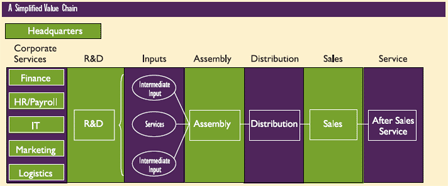
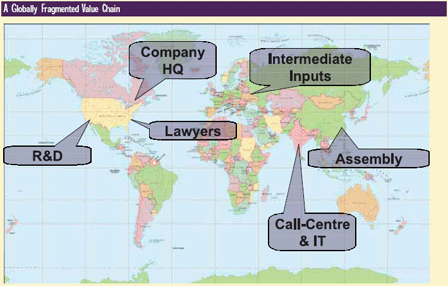
How Important are Global Value Chains?
Global value chains are not new. They have, to some extent, existed as long as there has been trade in intermediate inputs. The Hudson's Bay Company(1670)4 or the East India Company (1602)5 can be thought of as managing a global value chain; sourcing inputs from around the world to be processed in Europe and sold globally. But the importance of global value chains has been limited by barriers to trade and investment, by high transportation costs and a limited ability to communicate between far-flung operations. Far more common was the production of end products in one country for sale in another (traditional trade) or branch-plant production (products produced in many markets around the world largely for sale in those markets). But, this is now changing; the import content of exports is increasing in most countries, international trade is increasingly in the form of intermediate inputs, trade in services is becoming ever more important and investments are increasingly part of a regionalor even global production networks forming vast global value chains. And, with a growing number of activities able to be traded and a growing share of the world's population actively taking part in this trade, the impact may be huge.
There is no one statistic available that can capture the extent to which global value chains exist or have increased in importance in recent years. The diagram below illustrates a hypothetical global value chain and illustrates this point. This diagram depicts a fictitious Canadian company; the firm’s headquarters is located in Montréal, research and development (R&D) is conducted in California, the company’s lawyers are located in New York, and call-centre and information technology (IT) services are provided from India. The final product is sold globally, including in Canada, while assembly is based in China with intermediate inputs coming from Eastern Europe.
In this example, if we were only able to measure merchandise trade flows, all we would see is exports of intermediate inputs from Eastern Europe to China and then Chinese exports to countries across the globe. Canadian statistics would register only imports from China. When we add services trade, we would presumably see payments of services from the Canadian headquarters to R&D and lawyers in the U.S., the call-centre in India and management services from manufacturing operations in Eastern Europe and China. But all of this would depend on how the company is structured. There would also be the profits made in countries around the world that would be returned to the HQ in Montréal. Finally, adding foreign direct investment (FDI) we would expect to see outward flows of investment (also called Canadian direct investment abroad) as these facilities are established around the world and as new investments in machinery, equipment and so on are incurred. If portions of the value chain are outsourced to other companies, such as the IT services in India being provided by an Indian company rather than a Canadian one, we would expect to see payments for services from the Canadian headquarters to the contractor in India and we would not see any FDI flows between Canada and India.
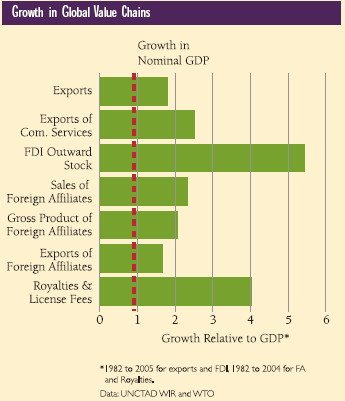
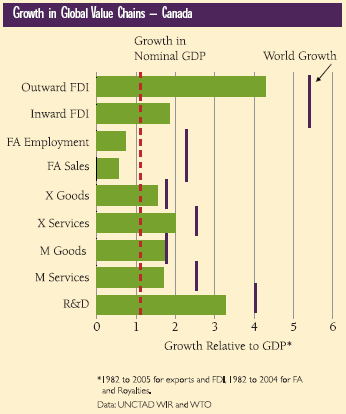
It can therefore be extremely difficult to measure global value chains on a global level, but even more difficult to assess where (or how well) a country fits into these chains. It is therefore useful to employ a number of measures to capture the importance of global value chains to the economy. Where Canada fits into these global value chains and how Canadais fairing in terms each value chain activity will be discussed in more detail in later chapters.
The first chart employs a number of measures to illustrate the rising importance of global value chains world-wide. Taking global GDP growth as the basis – anything that is growing faster than GDP is, in effect, becoming more important to the economy over time. Between 1982 and 2005, world-wide GDP grew by 310%; by contrast global exports grew by 553% and trade in commercial services increased by 779% - more than twice as fast as global GDP.6 Outward FDI stocks expandedat an astonishing 5.4 times the rate of GDP. A variety of measures of the output of foreign affiliates also increased at much faster pace than GDP showingthe growing importance of foreign affiliates for the global economy and royalties & licence fees, a proxy for the internationalization of R&D and knowledge, grew by more than four times the rate of growth of GDP.7
Globally there were 37,000 multinational enterprises (MNEs) with at least 170,000 foreign affiliatesin operation in 1990. In 2004, only 14 years later, the number of MNEs had nearly doubled to 70,000 and the number of foreign affiliates expanded four-fold to 690,000. Furthermore, more than one-quarter of parents and almost half of affiliates are now located in developing countries.
Similar indicators for Canada reveal that global value chains are increasingly important for Canadaas well, with all indicators, except for the operations of foreign affiliates abroad, growing faster than Canadian nominal GDP. Goods exports, for example grew one and a half times as fast as GDP and services twice as fast while outward FDI stocks grew three times as fast as GDP. Consistently, however, global growth in these same indicators grew even faster, suggesting that while Canada is participating in global value chains, it is not participating to the same extent as other countries.
Even these measures do not fully capture the rise of global value chains. FDI can be both tariff-jumping branch plants or resources extraction as well as specialized plants integrated into a global production system. Trade can be both traditional; production in one country for sale to consumers in another, as well as trade in intermediate inputs. Some of these issues will be addressed later in this paper while others will have to be left for another venue.
The Impact of Global Value Chains
In the popular press, much of the impact of the rise of global value chains has been focussed on the offshoring of jobs – ceasing an activity at adomestic location in order for it to be performed at a foreign location, often in a low-wage country.8 For some, the increasing possibility of these off-shored activities being service sector jobs that would have been previously considered non-tradable has added to the concern.
Estimates of the huge number of jobs that are potentially internationally mobile have grabbed the headlines: Blinder (2006), for example, estimated that as many as 41 million jobs in the U.S. are potentially offshorable. McKinsey Global Institute(2005) put the figure at 160 million world-wide. Van Welsum and Vivkery (2005) estimate that potentially affected occupations account for 18.1% of employment in the U.S., 19.2% in the EU-15 and 18.6% in Canada. Bardhan and Kroll (2003) put the figure at about 15 million service sector jobs for the U.S. (11.7% of total employment in 2003). Other estimates put the range at between 10-21% for the U.S. For an overview of these estimates see Kirkegaard (2007). Another way to read this is that these estimates represent the upper limit of the number of jobs that have or could potentially become tradable. They are usually based on what jobs require a physical presence such as; taxi drivers, waiters and doctors, and which do not such as; financial analysts and computer programmers. This has added to fears relating to offshoring as many of the jobs thought to be potentially off-shorable are ones that had previously been belived to be immobile. Furthermore, they tend to carry attractive salaries, and are either filled by members of the middle class that had previously been immune to the effects of offshoring or are filled from among those who had been displaced from manufacturing jobs that had migrated earlier.
But these fears seem largely unfounded. An update to an often cited study by Forester Research predicts that for the U.S. as many as 3.4 million service sector jobs may move offshore by 2015.9 A simple scaling and adjusting for differences in industrial structure would suggest that for Canada this would be about 240,000 service sector jobs. While this may seem like a large figure, this would representabout 2% of U.S. employment in the service sector in that year (and a similar amount for Canada).
Data from the U.S. Bureau of Labour Statistics show that 3.9% of mass-layoffs in a given year are from work moved offshore (not just services, but manufacturing as well). These 33,200 job losses are extremely small compared to the total 7.4 million jobs that were lost in that same year for a wide variety of reasons and even less when compared to the 8 million that were created. This is similar to an estimate for the EU which puts the figure at 4.5%.10 It is also important to note, that while the absolute number of lay-offs due to off-shoring may be small, those that do lose their job for this reason are, on average, unemployed for a longer time and when they do find work it is more likely to be for lower pay.
Although the media have often highlighted the challenge associated with the rise of global value chains, namely the movement of jobs abroad through off-shoring, the benefits have largely been ignored. It is a too simplistic view of the world to believe that a purchase of an activity from abroad is a loss of a job for Canada. Rather, it must be thought of as an exchange and like any form of trade both parties will benefit.
As a company grows overseas it also often expands its activities at home. Evidence from the U.S. shows that expanded overseas activity by a country's multinationals leads to more employment in the home country as well.11 While employment at U.S. affiliates outside of the U.S. expanded by over 2 million between 1997 and 2004, employment at their U.S. parents increased by 1.5 million. International growth also allows the company to spread its R&D costs over greater volume of sales and thus investmore in R&D. It exposes the company to the best in the world forcing the company to be more innovative and transfers some of that knowledge back to the domestic economy. Canadian multinationals, for example, have been shown to be more productive than are purely domestic companies.12 And, Canadian multinationals repatriate profits back to their parent in Canada. In 2006, Canadian direct investments abroad generated $30.6 billion that was returned to Canada, a nearly three-fold increase from ten years ago.
It is also important that Canadian firms, both large and small, link into global value chains. The extent to which this is already occurring is discussed in the manufacturing and services sections of this report, however, the benefits are clear. By sourcing intermediate inputs or services abroad, Canadian operations can become more efficient and survive, if not expand, in an increasingly competitive global environment. Amiti and Wei (2006), for example, find that services offshoring for the U.S. manufacturing sector contributed to 11% of productivity gains while having almost no impact on employment levels. A cost benefit analysis by McKinsey Global Institute (2003) found that the host country gains $1.12 to $1.14 for every dollar of activity offshored.
Thus, it is important that companies located in Canada not only have access to foreign markets in which they can sell their goods and services, but also be able to import intermediate inputs and services.
The Driving Forces
Understanding what is driving the globalization of value chains will help us to understand why global value chains are taking hold at this particular time; why there is an increased fear now that production will move to low-wage countries even though there have always been significant differences in cost structures among countries, and; whether or not these trends will continue. Three forces appear to be driving the growth in global value chains: 1) Declining costs of transportation; 2) Improvements in information and communication technologies (ICTs); 3) Reduced barriers to international trade and investment and the adoption of market oriented economic policies. We will expand on each of these themes in turn.
Declining Costs of Transportation
Declining costs of transportation allow goods or services to be transported greater distances without losing competitiveness relative to those produced locally. Some of the benefits of lower-cost production are lost in the cost of transporting intermediate products or final outputs to where they will be consumed. Transportation costs play an important role in agglomeration economies – why producers of intermediate inputs have a tendency to locate in close proximity to the user of those inputs. The automotive sector in Southern Ontario and the mid-Western/North-Eastern U.S. is a prime example. As transportation costs decline, all else being equal,there is less incentive to locate in close proximity to either suppliers or consumers and thus take advantage of the strengths of more distant locations.
For Canada, transportation and warehousing costs now account for 6.5% of the cost of inputs used to make the goods and services that are produced in Canada. This is down from 10.3% in 1963.13 For goods, the size and weight of the product relative toits price impacts on the cost of transporting it and thus how far away from the customer it makes economic sense to produce the good. Small and lightweight products can travel greater distances for the same cost of transportation than bulkier and heavier products. The electronics industry, for example, is one of the most globalized industries, in part, for this reason. But also important is the cost of transportation in terms of time. It costs money to stock-pile and store products. Many products are also perishable, such as food which can spoil, but also electronic goods which are quickly overtaken by technological advances or clothing that is subject to rapidly changing fashion trends.14

Reduced costs of transportation is also important for the movement of people for the delivery of services, the management of distant business units, the meeting of R&D collaborators and the monitoring of suppliers or scouting for investments. When it comes to the movement of people, the overall cost is important which includes the actual cost of the ticket, the time spent traveling, both in the air and on the ground, and the availability to travel when the need arises (the frequency of flights, for example).
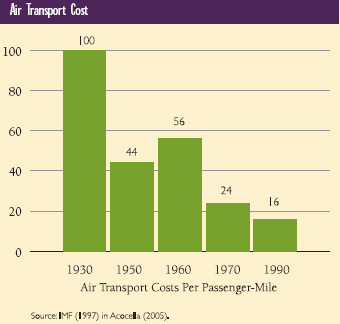
Containerization is the most often cited advancement in international transportation of goods, butthe evidence that this has led to a sustained reduction in the real cost of transportation is mixed. Direct measures of the cost of ocean transport showa rapid decline up to the 1960s but little movement, possibly even a slight increase, since then. The fact remains, however, that containerization has become the dominant form of marine trade and there must be a reason for this. As recently as 1980 containerized shipping accounted for only 21% of all marine shipping, but by 2000, this had increased to 70%.15 The answer appears not to be direct cost savings, but savings in terms of time of both the journey itself and the loading-unloading process. It is estimated that the average trip time of the ocean leg of an international journey has decreased by about half as a result of containerization and is thus this time savings that has contributed to the rising popularity of this mode of transport. The improvement of transit times alone is estimated to be the equivalent of reducing tariffs from 20% to 5.2%.16
Another significant improvement in international transportation has been in air transport. Air transport costs have declined considerably for both cargo as well as passenger travel, falling by about a third since the 1960s. Not captured by the declining costs but also important are more frequent flights and more direct flights. Although air transport is still significantly more expensive than marine transport, it is of course much quicker as well. Further demonstrating the importance of time as a trade cost is the rising use of air transport in trade. More than one-third of U.S. exports by value are now shipped by air and this figure jumps to more than half if exports to Canada and Mexico are excluded (for which ground transport is particularly important).17 For Canada, 31% of exports to non-U.S. destinations are by air, roughly double the share only ten years ago.
In total, it is estimated that the advent of faster transportation (air shipping and faster ocean travel) is equivalent to reducing tariffs on manufactured goods from 32% to 9% between 1950 and 1998.18
Improvements in Information and Communication Technologies (ICTs)

Improvements to communications–lower costs, more reliable service, greater access of all forms of communications including voice, video and data–make it easier to control far-flung operations, make deals, access information and coordinate activities. In addition, improvements in ICTs make it possible to trade services that were once considered non-tradable such as computer programming, offering financial services or a radiologist reading an X-ray.
It has been calculated that the average cost of processing information fell from $75 per million operations to less than one-one hundredth of a cent between 1960 and 1990. And, the cost of a three minute telephone call from New York to London fell from $245 in 1930 to under $50 in 1960 to $3 in 1990 to about 35 cents in 1999 (all in 1990 prices).19
These figures only capture the tip of the iceberg in terms of the transformative effect that technological improvements have had on trade. For example, because of standardization of software formats, an engineer in Russia can collaborate on producing an engineering drawing with a colleague in Winnipeg, but there is no good statistics which can adequately capture this innovation.
Reduced Barriers to International Trade and Investment and the Adoption of Market Oriented Economic Policies
The GATT was set up by 23 countries in 1948 and had increased to 128 by the time it became the WTO in 1995 and has since grown to 150 members. There are now more than 300 bilateral and regional trade agreements in existence, up from only 120 in 1995. The number of bilateral investment treaties has increased even faster, from 385 in 1989 to 1,857 in 1999 and to more than 2,500 in 2006.20 The average tariff rates among OECD countries have fallen from around 40% just after WWII to about 4% in 1993.21 But not all reductions in barriers to trade or movements of capital were done as part of joining the WTO or as a result of signing a bilateral free trade or investment agreement. Much, especially for many developing countries, was done unilaterally with the knowledge that such liberalizations would be good for their economies. By 1997 India had reduced its average tariff rate to 30%, from 82% in 1990, Brazil from 25% in 1991 to 12% and China from 43% in 1992 to 18%.22 And it has not only been barriers to international trade and investment that have fallen but other pro-market reforms have been undertaken. For some it was the outright collapse of communism, others market reforms within a communist system and still others a shift from inward looking policies of import substitution to outward oriented growth policies.
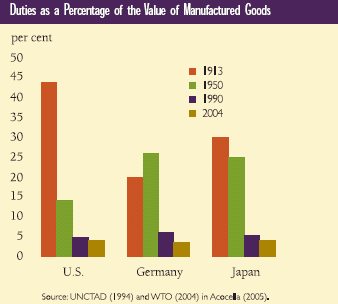
Manufacturing
As of the end of 2006, the manufacturing sector employed just over 1.8 million Canadians, representing 12.8% of total Canadian employment. The manufacturing sector share of GDP was slightly higher at 15.9% reflecting higher productivity and wages in manufacturing than the national average. Salaries in the manufacturing sector averaged about $45,000 compared to the average for all industries of about $35,000. Manufacturing in Canada, as in most advanced countries, has been declining for a long time as a share of GDP and employment, although the value of manufacturing output has remained relatively sTable. Some of the relative decline has been the result of outsourcing of services – services that were once considered part of manufacturing are now being done by separate companies and are thus classified as belonging to the services sector. Also, consumers in most advanced countries consume a greater share of services compared to manufacturing. The other main contributors have been productivity improvements in manufacturing that have allowed output to remain high while employing less people and finally the movement of manufacturing abroad.
Canada witnessed a short-lived rebound in the manufacturing share of the economy over the 1990s which peaked in 2000 at 19.0% as a result of theCanada-U.S. FTA and depreciating exchange rate.23 More recently, the manufacturing sector in Canada has had some difficult years. Canadian manufacturing employment has declined by 11.8% (244,000 jobs) since its peak in November 2000 although realoutput is down by much less; declining only 2.7% between 2000 and 2006. Over that same period, Canadian manufacturing exports fell by $3.6 billion in nominal terms while imports rose by $22.4 billion. Factors affecting this shift from exports to imports include a significant appreciation of the Canadian dollar (it rose from US$0.64 in 2002 to US$0.88 in 2006 – an increase of 38.5%) and restructuring in the automotive sector. Canadian exports of cars and parts were down $13.4 billion, thus manufacturing exports excluding this sector would have been up by $9.8 billion. But, as a result of the manufacturing boom over the 1990s, the current decline in manufacturing still gives Canada a higher share of manufacturing in GDP than many developed economies (and thus a lower share of services, but more on that later).
Although some of this decline may be due to manufacturing production moving offshore, it is likely avery small contributor. In 2003, the latest year for which data is available, the trade deficit in manufacturing amounted to only two and two tenths of one percent of Canadian manufacturing output. So even though the trade deficit more than doubled by 2006, it still remained extremely small compared to the total output of the industry. Moreover, a recent survey by Canadian Manufacturers and Exporters identified a lack of skilled workers as one of the most important issues facing manufacturers.24 This would suggestthat not only are the high-skilled manufacturing jobs not leaving Canada, but quite the opposite, there currently appears to be excess demand.
Are Canadian Manufacturers Sourcing Internationally?
One concern that has been raised is that Canadiancompanies are not taking advantage of the rise of global value chains by sourcing internationally. It is argued that by sourcing some intermediate inputs internationally will allow Canadian manufacturersto become more competitive and expand other higher-valued activities in Canada.
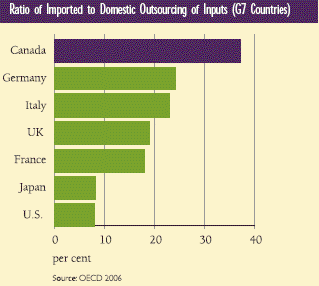
In support of the view that Canadian companies are not sourcing from abroad, in 2002, the most recent year for which comparable data is available, there were about 44,500 establishments that exported goods abroad, but nearly 64,200 that imported goods – almost 50% more. But, many of these importers are retailers or wholesalers that would be importing final goods, only 16,700 were manufacturers that would be much more likely to be importing intermediate inputs. This compares to roughly 20,800 manufacturing exporters.
On the other hand, 37% of intermediate inputs used in Canada in 2003 were imported. That places Canada among the top third of OECD countries and the highest for a G7 country for the ratio of imported to domestic outsourcing of inputs.25 This is supported by the findings of Baldwin and Gu (2007) which show that over the period of 1961 and 2003, the foreign component of material inputs in Canada almost doubled. One may conclude then, that while Canadian-based companies are taking advantage of international sourcing opportunities in order to remain competitive, smaller firms may not be participating as much as larger Canadian and foreign owned companies operating in Canada.
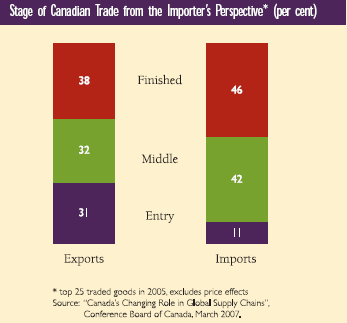
Where do Canadian Manufacturers Fit in Global Value Chains?
One way to answer this question is to look at what Canada is importing and exporting from the point of view of the other country. Not surprisingly, a highshare of Canada's exports are in entry-level goods; unprocessed goods such as resources and resources-based goods. If entry level goods are excluded, Canada has a somewhat higher proportion of the remaining exports in finished products as opposed to intermediate goods. For imports, entry level goods account for a relatively small share of imports while finished goods account for only a slightly higher share of imports than intermediate goods. With about half of Canada's non-entry level trade (exports and imports) in finished products it is difficult to know whether this is high compared to other countries and thus potentially signifying that Canada is, or is not, participating in global value chains. Also, the interpretation of this evidence is unclear as an increasing share of world trade is indifferentiated products meaning that it is not unexpected that Canada might import car parts and then export cars, but also import cars of other brands. It is also difficult to tell from this information if Canada is specializing in the production of intermediate inputs or in the assembly of finished products.
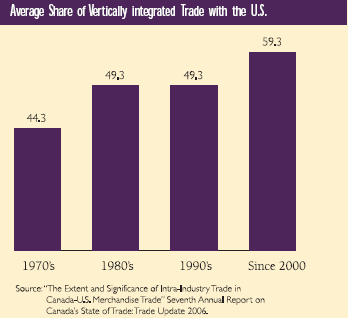
A possibly more revealing measure of this same trend is to look at vertically integrated trade, trade that occurs within the same industry but is at different stages of production such as the importation of automotive parts and the exportation of completed vehicles. The proportion of Canada's trade with the U.S. that is of the vertically integrated type has been on the rise for the past two decades and now accounts for more than half of Canada's trade, meaning that Canada is either importing intermediate goods and then exporting something more finished or vice-versa. This provides strong support for Canada actively participating in global value chains as well as the increasing importance of global value chains for the Canadian economy.26
It has also been argued that the reliance of Canadian exports, especially manufacturing, on the U.S. market is overstated due to Canadian exporters selling to a U.S. multinational which in-turn exports to many more destinations. There is no data available on what share of Canadian exports to the U.S. are sales to U.S. multinationals which may then be shipped back to Canada or to overseas markets. However, we do know that 34% of Canada-U.S. trade is intra-firm – between parts of the same company operating on both sides of the border. Also, US$58.9 billion worth of U.S. goods imports are from U.S. foreign affiliates operating in Canada selling to their parent company. Applying the same ratio of purchases by U.S. parents from their affiliates in Canada to their total purchases (i.e., including non-affiliated purchases) suggests that another US$70 billion of U.S. goods imports from Canada are purchases by U.S. multinationals sourcing from unaffiliated companies in Canada – basically half of U.S. imports from Canada are either U.S. affiliates operating in Canada shipping goods back to their parent company (accounts for 45.6%) or unaffiliated Canadian companies shipping goods to a U.S. multinational (54.4%).27
Canada as an Internationally Competitive Location for Manufacturing

As will be argued throughout this report, the greatest impact of the rise of global value chains for Canada will be the challenge of attracting and retaining high valued activities in Canada. As functions become more internationally mobile, competition from others to attract them will increase and small differences in economic environment may become increasingly important.
For the manufacturing sector the story is mixed. As noted already, Canada continues to have a higher share of the economy in manufacturing than most other advanced countries but not as much as some, such as Germany. And while the Canadian manufacturing sector grew as a share of the economy of the 1990s based on the impact of the Canada-U.S. FTA, NAFTA and a declining dollar, the sector has been struggling in recent years.
Trade surpluses or deficits can provide an indication of where a country possesses a comparative advantage. Canada has generally maintained a small deficit in manufacturing over the 1990s and into 2000, posting surpluses only in 1995 and 1996. Since 2002, as the Canadian dollar began to appreciate, Canada's trade deficit in manufacturing has generally been increasing. In 2006 it reached a recent peak of $27.8 billion or just under 9% ofmanufacturing exports. But this hides a lot of detail. Canada possesses sizable trade surpluses in a large number of industries within manufacturing, some related to the processing of resources but others in high-tech manufacturing.
Canada has traditionally been very successful in attracting manufacturing facilities from abroad.
Roughly one-half of the sector, by assets or revenue, consists of foreign producers. Canada has also been attracting ever more investment from the U.S., our most important investor. Canada's share of the manufacturing capabilities of U.S. multinationals, as measured by assets, has increased from 11.7% in1997 to 14.5% in 2004 which would suggest that Canada continues to be an attractive location for manufacturing investment.
Services
For many, the greatest concern about the rise of global value chains is the offshoring of services. While manufacturing has long been considered tradable, it was often claimed that any lost jobs in manufacturing would be more than made up for with better, cleaner and higher-paying service sector jobs. But where will the jobs come from now if those same jobs can be done from a low-cost country as well?
As noted in an earlier section of this study, estimates of the number of service sector jobs that are potentially offshorable vary widely but can be quite considerable. Another concern is that a sizable number of those occupations that are thought to be newly offshorable are considered to be well paying and moderately to high-skilled.
A central concern is the potential for emerging markets, with much lower wage rates, to compete for these jobs. One study puts the number of young professionals in developing countries at 33 million.28 This is compared to about 15 million in high wage countries. If support staff, doctors and nurses of all tenure groups is included, this figure jumps to 392.8 million in low wage countries and 181.3 million in high wage countries.29 But not all skilled workers are of the same quality. Another estimate suggests that only around 13% of these are of suiTable quality to work for a global MNE in their field of specialty. Using a broader measure of those holding university degrees puts the number of potential skilled workers at 930 thousand in China and 750 thousand in India alone compared to 1.5 million in the EU, 1.3 million in the U.S. and 129 thousand in Canada.30
To What Extent is Services Offshoring Occurring in Canada?
Canada currently has a sizable trade deficit in commercial services which, to some extent, can be viewed as offshoring of services. However, similar to manufacturing, as a share of total output of the sector this deficit is tiny, suggesting that offshoring of services to date has had only a minimal impact on Canadian jobs. In 2005, Canada exported $35.1 billion in commercial services and imported $37.9 billion for a trade deficit in commercial services of $2.8 billion. Canada had small surpluses in computer and information services ($1.6 billion) and management services ($0.2 billion), the two categories of commercial services most closely associated with offshoring. And, 88% of Canada's commercial service imports were from rich countries – Canada had a sizable trade surplus of $3.1 billion in 2004, the latest year for which data was available, with low-wage countries. Canada's commercial services trade with India, accounted for only one-fifth of one per cent of Canada's total commercial service imports. Moreover, Canada had a trade surplus of $37 million with India, representing nearly half of imports in 2004. About all that can be said is that Canadian commercial service imports from India have grown fast in the past number of years; more than tripling since 1999 and growing by 73% between 2003 to 2004 alone. A recent study by Morissette and Johnson (2007) supports this view. They find that, with the exception of clerical employment, there is no evidence that occupations that are most subject to offshoring witnessed weaker employment growth. "Between 2000 and 2006, employment in occupations potentially affected by service offshoring grew 1.8 per cent per year, on average. Employment in other occupations grew at the same rate".31 In the case of clerical employment, the authors conclude that these losses occurred too early and in industries that are unlikely to be subject to offshoring and are thus probably not relatedto the offshoring phenomenon.
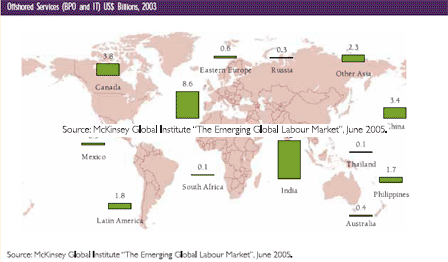
Baldwin and Gu (2007) find that between 1961 and 2003, there has been a trend of increased outsourcing of services (replacing what was once done inside the firm toward arms-length purchases–outsourc-ing) by the manufacturing sector, but even more so for the service sector itself. Furthermore, an increasing share of these purchases were from outside of the country (offshoring). The share of imports in service inputs almost tripled over the period. They also find that services offshoring is associated with a shift to higher value-added activities being performed in Canada but has not had a detrimental impact on service employment.
As with manufacturing, there is also a concern that Canadian companies are not taking full advantage of the opportunities raised by the ability to move some work to lower-cost locations. It has been found, for example, that a one percentage point increase in offshoring in the services sector leads to a 0.43 to 0.57 percentage point increase in labour productivity.32 Outsourcing, as expected has had a positive impact on the wages of non-productionworkers, on the wages of skilled workers and on employment of skilled labour.33
Canada as a Services Offshoring (inshoring) Destination
Canada, it has been claimed, is a net beneficiary of services offshoring. A study by McKinsey Global Institute (2005) ranked Canada third in the world behind India and Ireland in terms of locations for offshored services. But, most of this seems to belower-end call-centres rather than high-skilled ITservices. While Canada accounted for 11% of newcall centres Canada only accounted for 2% of highvalue-added information technology centres.34 Contrary to this, and again using trade balances as an indication of comparative advantage, Canada has sizable trade surpluses in many of the categories of commercial services that are most closely associated with services offshoring. For example, in 2005, Canada exported nearly 40% more computer and information services, and architectural, engineering and other technical services than were imported.
But, Canada seems to be lagging in terms of moving to a service based economy more generally. Services as a share of the total economy is among the lowest of the G7. And although Canada ranks 9th in the world in terms of merchandise exports, as of 2005, Canada ranked 15th in the world for service exports. This was well below many much smaller countries such as the Netherlands, Ireland, Belgium and Austria and represented the second worst growth rate among the top 15, meaning that Canada will fall even further behind if that trend continues. Canada also attracts less investment in skilled services relative to the size of the sector. While foreign controlled firms account for more than 50% of assets in the manufacturing sector, they account for only 15.5% in professional, scientific and technical services.
Summing up, offshoring of high wage services to low wage countries is not currently an issue for Canada and while this phenomenon is growing quickly it will remain small for some time to come.

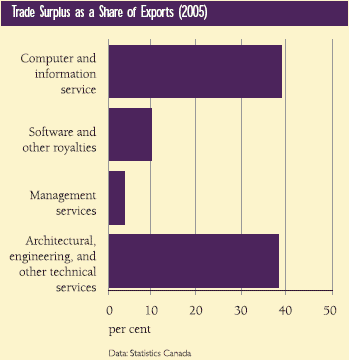
The bigger issue for Canada may be why Canada is not a more important global player in high-value and high-knowledge service industries and how Canada can become a location of choice from which to supply these services to a global market.
Research and Development (R&D)
Research and Development (R&D) is one of themost sought-after activities. Innovation is the only method by which a country can achieve higher standards of living for its citizens over the long run. While it is possible, to put more people to work, have them work longer hours or give them more machinery to work with, that can only take a country so far. It is only through finding new methods of working, making improvements to machinery and human knowledge and by making breakthroughs in everything from home electronics, to life-saving drugs and environmental technologies that a society can continuously improve its living standards.
Furthermore, jobs in R&D are seen as being relatively well paid, employing highly skilled people and having spill-overs to the surrounding community encouraging even more R&D to take place. Ottawa, for example, not only benefits from the government research facilities and large companies that have chosen to locate their R&D there, but also all of the small, and not-so-small, companies that have been fostered by that initial investment. According to Research Infosource, 27 of the Top 100 corporate R&D spenders in Canada are based in Ottawa and 27 per cent of the total R&D expenditures from those top 100 companies is spent in Ottawa. Also, by undertaking R&D and creating new products or services, a company has greater pricing power allowing them to return profits to the local economy rather than simply competing onprice. This issue will become increasingly importantas ever more activities are commoditized.
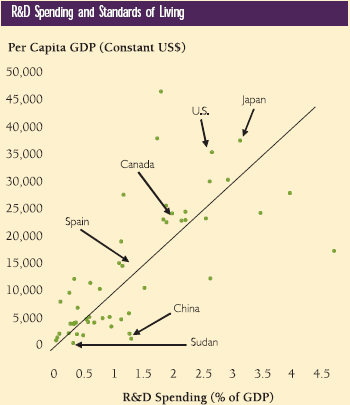
All countries are recognizing the importance of conducting R&D for maintaining and growing their standards of living. It is therefore not surprising that countries are increasingly in competition to attract R&D activities. And like many activities, emerging markets are increasingly participating as well.
But just as other stages of the value chain are becoming increasingly footloose, so to are R&D activities. While once these functions would be located in close proximity to the corporate headquarters due to the complex and tactile nature of R&D and the need for researchers to have face-to-face contact, this is becoming less necessary. This has happened for a variety of reasons, some of which are the same factors that are affecting other functions, such as technological improvements that make it easier to communicate over distances and at lower costs. The Internet after all was first adoptedby researchers to communicate and coordinate their work. Standardized software allows an engineer to read and modify a file produced by a colleague on the other side of the planet, potentially allowing for 24 hour R&D. Even seemingly unrelated advances, such as more liberalized air travel resulting in more direct flights and at lower costs, again facilitate communication and control. But also as firms facegreater competition they must look at methods for improving efficiency and value in all of their functions, including R&D, driving them to consider moving these functions to access specialized skills, lower costs or for other reasons.
German multinational enterprises, for example, established more R&D units outside of Germany in the 1990s than in the preceding 50 years combined.35 Multinationals are spending more on R&D in both their home country and abroad, but spending outside of their home country has been increasing twice as fast as spending at home. On average, 16% of all R&D spending by multinational enterprises was spent outside their home country in 2002; this is up from only 10% in 1993. Spendingon R&D outside of the U.S. by U.S. multinationalsincreased from 11.5% in 1994 to 13.3% in 2002. While this change, only 1.8 percentage points, may seem small, it is equivalent to US$2.9 billion or roughly one-third of total Canadian business sector spending on R&D in that year.
Canada's over-all R&D performance is poor. R&D as a share of GDP in Canada has risen from 1.7% in 1995 to 2.0% in 2006, but still below the OECD average of 2.3%. And, much of this increase has beena result of increased government spending on R&D. In particular, higher-education's share of R&D spending in Canada rose by 10 percentage points to 37% of R&D spending in Canada while the federal government and business sector shares both declined. Taking only business sector spending (removing government as well as quasi government such as healthcare and universities) Canada's spending as a share of GDP is only 1.0% of GDP, roughly two-thirds of the OECD average and well below top performers such as Finland and Japan (each at 2.4%).
Canadian exports of R&D services grew by 316% between 1990 and 2005 and account for 8% of Canada's commercial service exports. Payments for royalties and license fees exploded by over 3300% since 1990 and accounted for 12% of commercial service exports in 2005. However, while Canada maintains a sizable trade surplus in R&D services,the reverse is true for royalties and license fees.
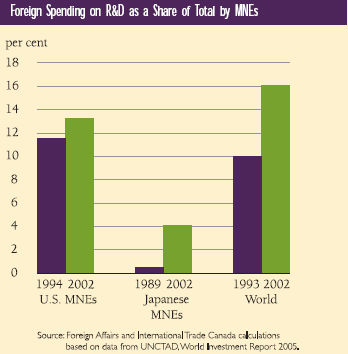

Interestingly though, while two-thirds of Canada's R&D exports were with affiliated companies since2000, the reverse was true over the 1990s. Thus,while it has been multinational companies undertak-ing much of the R&D for export more recently, thishas not always been the case. Although, it is difficult to confirm, it may be that smaller Canadian companies have lost some of their attractiveness for internationally contracted R&D activities in recent years.
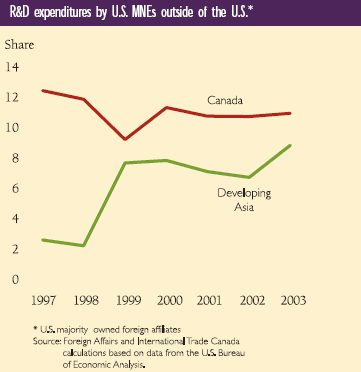
Foreign affiliates (foreign-owned firms operating in Canada) account for more than one-third of business sector R&D spending in Canada (roughly their share of the Canadian economy) and another 5% is performed by Canadian firms but funded from foreign sources. This means that nearly 40cents out of every dollar of business sector R&D spending in Canada has some involvement of a foreign source. This is not surprising as the 700 largest R&D spenders accounted for 69% of the world's business spending on R&D and only a small number of these are Canadian. Siemens alone, for example, spends more on R&D than either Brazil or Russia.36
But on direct measures of Canada's attractiveness as a location for foreign multinationals to locate their R&D activities, Canada is not performing well. Canada's share of North American (Canada and the U.S. only), all developed countries and even the world have all fallen. This means that Canada is not losing share only because there are new competitors on the scene, such as China, or India, but also against developed countries, which includes the EU and Japan, and probably most importantly the U.S. – our primary competitor in North America. U.S.-based multinationals are particularly important for Canada, yet here too Canada's performance has not been strong. Canada's share has declined modestly from 12.5% in 1997 to 11.0% in 2003. But just this 1.5 percentage point decline is roughly the same value as all of the R&D spending by U.S. multinationals in Australia.
The importance of new competitors is extremely evident. The developing economies of Asia accounted for less than three per cent of R&Dspending by U.S. multinationals outside of the U.S. as recently as 1998 but accelerated sharply thereafter and as of 2003 stood at nearly 9%–a more than three-fold increase in only five years. In the section relating to manufacturing, we discussed the total number of low-skilled labourers that China alone could potentially add to the global economy. But potentially more important for Canada in attracting and retaining high-valued activities such as R&D is the number of skilled people. While estimates of the number of science and engineering graduates in these emerging economies vary widely we will pick one; the U.S. National Science Foundation 2006 report which gives the number persons holding first degrees in science and engineering as of 2002, or the most recent year available, lists 534 thousand for China, 176 for India, 60 thousand for Canada and 416 thousand for the U.S.37In addition to the wide range of estimates of the number of science and engineering graduates, the quality of their education is also questionable. McKinsey came to the conclusion that only 10% of Chinese engineers and 25% of Indian engineers were of sufficient quality to be employed by a multinational.38 Even so, this would suggest that emerging markets will be increasingly capable competitors for highly sought-after internationally mobile R&D activities.
Headquarters
Corporate headquarters often contain many of the highest paying positions in a company such as management, finance, legal, accounting, human resources and so on. These are often called 'head-quarter functions', but as with other stages of the value chain, their links to a specific location or to other functions are weakening. They too are becoming increasingly mobile. Indeed, much of the fear surrounding offshore outsourcing is the potentialloss of these high-paying and high-skilled activities to low-wage locations. And, even more so than R&D, corporate headquarters (HQs) can have an impact on the local and in some cases even the national economy well beyond the impact of their direct employment – banks are worried about loosing their customers, stock exchanges their listings and auditors and lawyers their clients. Furthermore, the headquarter embodies the decision making power of the firm, provides the top management positions for all members of the firm to aspire to, is often associated with local philanthropy, and can act as a national champion. It is for these reasons that corporate headquarters, and their associated functions, are among the most sought-after activities. This may be best illustrated by some high-profile headquarter movements in recent years. In 2001 Boeing relocated its headquarters from Seattle to Chicago and is expected to employ about 500 people. One of the reasons cited for the move was the generous incentives offered by the State of Illinois and the City of Chicago estimated at about US$62 million in tax breaks, grants and other benefits. That puts a value of about US$124 thousand per employee.
Canadians in particular have been worried about the state of their head offices. In the late 1990s and into the early part of this decade, there was a concern that the low value of the Canadian dollar was contributing to an acceleration of takeovers of Canadian companies by foreign raiders at 'fire-sale prices' and resulting in a 'hollowing out' of corporate Canada. More recently, this fear has been renewed with the large number of foreign acquisitions of Canadian companies that have taken place in recent years even as the dollar has appreciated. Some of Canada's most recognizable corporate names havebeen acquired by foreigners including; Hudson's BayCo., Falconbridge, Inco, Dofasco, Algoma Steel and Four Seasons Hotels. Royal Bank CEO Gordon Nixon noted that "Over the past year, 116 Canadian public companies were acquired by foreign interests, more than any other major country including much bigger economies such as the United States, the United Kingdom, France and all of the Nordic countries combined".39
This raises two questions:
1)What has happened to the number of head offices in Canada?
2)Does it matter if these head offices are foreign owned?
On the first account, the total number of head offices in Canada has actually increased, rising to 4,161 in 2005 from 4,061 in 1999 while headoffice employment increased by even more, rising by 17 thousand to reach 175 thousand in 2005.40 As for the second question; foreign controlled firms accounted for all of the gains in the number of headquarters in Canada over this period and for 6 out of 10 net new headquarter jobs. It was also found that "As a result of foreign takeovers, more new head offices were created than lost and employment in head offices was as high after the takeovers had occurred than before."41 Although this evidence does not cover the most recent wave of M&A activity, over a significant period that was characterized by fears of 'hollowing out' the number of head offices and head office jobs not only did not decrease but actually increased and foreign acquisitions may have even improved the situation.
Looking at another source, the annual list publishedby Fortune Magazine of 500 largest companies in the world, the number of Canadian companies listed nearly tripled from 5 in 1995 to 14 in 2006.42 At fourteen, Canadian companies account for 2.8% of the listings–a slightly higher share of Canada in global GDP (2.5%). UNCTAD produces an annual list of the world's largest transnational companies which also takes into account, not only the size of the company, but the proportion of revenues and assets that are located outside of the home country. In the 2005 ranking, the most recent available, there were three Canadian companies listed–again, as lightly higher share than Canada had in global GDP suggesting that Canada is doing about as well as one might expect.
Although Canada seems to be performing reasonably well, we must recognize that this can change quickly as head offices, like other functions, are increasingly mobile. Beckstead and Brown (2006) found that over the six-year period between 1999 and 2005, more than one-third of Canadian head offices disappeared (closed down or left Canada).The only reason that there was a net increase in head offices over this period as previously noted was that even more companies began operations or moved into Canada. There was a roughly similar amount of turnover in head office employment.43Data for the U.S. confirms this finding. Roughly 5% of head offices relocate in a given year (which would imply roughly one-third over six years as in the Canadian case).44
Although Canada's performance in attracting, retaining and growing headquarters can generally be characterised as good, some countries are doing better. Using the Global 500 list as the basis and scaled by GDP to take into account the size of the economy, some countries are performing much better. The global leader is Switzerland, with an economy about one third the size of Canada, has 12 of the world's 500 largest companies. The Netherlands, France, the U.K. and South Korea all perform significantly better than does Canada.
Also, Canadian companies are not generally global companies. Although there were 14 Canadian companies among the world's 500 largest, they largely ranked toward the bottom of the list. Thus, if one were to sum up the revenues of the global 500, the share of Canadian companies would constitute far less than Canada's share of GDP. Also, as Moore and Rugmen (2003) point out, Canadian companies tend to be regional players rather than global with most of their revenues coming from within North America. Only a small number of the Canadian companies listed make a significant portion of their revenues from outside of North America.45 It is well known that the U.S. accounts for a large share of Canadian exports; 75.9% in 2006. But this does not take into account the operations of Canadian foreign affiliates abroad which are much more geographically diversified than are exports. But here too, Canadian companies do not have the global presence of the multinationals of other countries. U.S. multinational enterprises (MNEs) have 21 times the value of sales outside of North America compared to Canadian MNEs and 18 times the number of employees. With U.S. GDP roughly 11 times that of Canada, this suggests that U.S. firms have about twice the international presence of Canadian firms even scaled by the size of theeconomy. But this may be changing. In the 1980s, 69.3% of Canadian outward FDI flows went to the U.S., in the 1990 and thus far in this decade, the share has been 48.9%.
Ontario's Institute for Competitiveness and Prosperity identified 72 Canadian-based global leaders; companies that claimed top-five status in a market niche. This was more than double the 33 they were able to identify in 1985 confirming the good performance that we noted earlier. It again must be emphasized that if this good performance is to continue Canada needs to have an environment that is conducive to attracting and retaining existing multinationals (both Canadian and foreign) as well as to grow new Canadian companies. The same study noted that only 16 of the 72 companies making the current list were also on the list in 1985. Thus the turnover is considerable and picking winners is difficult. Similar research for the U.S. arrives at generally the same conclusions; there is a high degree of turnover in corporate headquarters of which smaller firms growing to become the corporate champions of tomorrow constitutes an important part.
With the growth of China, India and others, Canada will account for an ever-smaller slice of the global economy. At the same time, companies will have a larger pie in which to do business and the average size of global players will likely increase. But the rise of global value chains may benefit Canada if we can attract the headquarters of these growing companies. Improvements to communications and transportation will lessen the need for companies to cluster their location. Thus it may be less likely that a few cities like New York, London, and Shanghai will host all of the world major companies and smaller locations in Canada can compete if they are able to offer an attractive location. The growth of other countries not only does not hurt Canada but is beneficial. The challenge for Canada is thus not to maintain a certain number of corporate head offices but for Canadian multinationals to grow to world class levels.
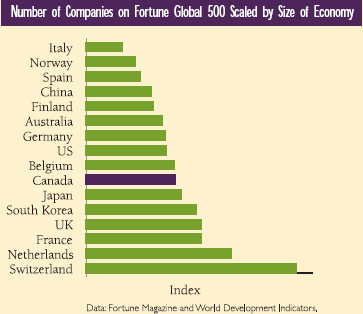

1 Aaron Sydor is Director of the Current and Structural Analysis Division within the Office of the Chief Economist at Foreign Affairs andInternational Trade Canada
2 For a more detailed description of the global value chainand how it relates to similar concepts, please refer to Appendix One.
3 Blinder, Alan S. (2006) "Offshoring: The Next Industrial Revolution?".
4 Establishment date from Encyclopaedia Britannica on-line.
5 Ibid
6 All figures in nominal US$
7 Note that GDP growth figures are indexed independently for each factor to adjust for differences in years covered by each factor.
8 For a definition of offshoring and related terms as they are used in this study please refer to Appendix Two.
9 As reported in Levine (2004)
10 U.S. figure is from the Bureau of Labour Statistics Mass Layoff Program which captures job separations affecting 50 or more employees. Data from the EU is from The European Restructuring Monitor as reported in "Offshoring, Outsourcing, and Production Relocation–Labour Market Effects in the OECD Countries and Developing Asia" Kirkegaard (2007)
11 For a reveiew of this evdince see Mankiw and Swagel (2006)
12 Baldwin and Gu (2005)
13 Author's calculations based on Canadian input-output Tables at the S-level of aggregation and exclude taxes, subsidies and labour inputfrom the value of total inputs.
14 For more on time as a trade barrier see Hummels (2001)
15 Rodrigue, J-P et al. (2006) The Geography of Transport Systems, Hofstra University, Department of Economics & Geography,
16 For a more detailed discussion on trends in international shipping rates see Hummels (1999)
17 Hummels (2001).
18 Ibid
19 UN "Human Development Report" 1999
20 UNCTAD, World Investment Report 2006
21 "The Road to Cancun" OECD in Washington No. 45, July 2003.
22 United Nations, Human Development report 1999 "Globalization With A Human Face"
23 For more on this, see Curtis and Sydor (2005)
24 20/20 Magazine, May/June 2007.
25 OECD "Draft Synthesis Report on Global Value Chains" (2006)
26 "The Extent and Significance of Intra-Industry Trade in Canada-U.S. Merchandise Trade", Box B, Seventh Annual Report on Canada's State of Trade, trade update 2007. Foreign Affairs and International Trade Canada
27 These are very rough calculations and should be used with caution.
28 Young proefessionals include engineers, finance, accounting, analysts, life science research and professional generalists with a university education and up to seven years of experience.
29 Sample of 28 low-wage countries and 8 high-wage countries. "The Emerging Global Labour Market" McKinsey Global Institute, 2005.
30 U.S. National Science Foundation 2007.
31 Morissette and Johnson (2007).
32 Amity and Wei (2004b)
33 Feenstra and Hanson (1999), Hijzen, Gorg and Hine (2003) and Egger and Egger (2001) respectively.
34 Trefler (2006-01)
35 UNCTAD, World Investment Report 2005.
36 Ibid
37 U.S. National Science Foundation 2006 appendix Table 2-37.
38 McKinsey Global Institute "The Emerging Global Labour Market: Part 2- the Supply of Offshore Talent in Services" June 2005.
39 Reported in the Toronto Star "Target Canada" April 21, 2007.
40 Statistics Canada Daily Thursday July 12, 2006. "Head Office Employment in Canada"
41 Beckstead and Brown (2006)
42 Fortune Magazine, annual global list of the world's 500 largest companies.
43 "Head Office Employment in Canada, 1999 to 2005" Beckstead and Brown.
44 Strauss-Kahn and Vives (2005)
45 Karl Moore and Alan Rugman, Policy Options 2003. 46See box of "Foreign Affiliate Trade Statistics (FTAS)"
Conclusions and Implications
The rise of global value chains means that activities can increasingly be located anywhere in the world based on where it is most efficient to undertake that activity. As well, technological advances are allowing for a greater number of activities to become internationally mobile including many high-skilled service jobs that were once considered non-tradable. And all of this is occuring within an environment where international competition for the highest valued of these activities is increasing. Not only are emerging competitors such as China and India quickly moving up the value chain, but traditional competitors are not standing still either.
Fear of lost jobs due to offshoring has dominated much of the debate to date, but as we have shown, this concern is largely misplaced. Not only have the headline figures for the number of jobs that are potentially offshorable greatly overstated the impact thus far, but they fail to capture the potential benefits. The real challenge presented by the rise of global value chains is to make Canada the location of choice for those high-value activities that are essential for maintaining an improving the standard of living of Canadians. In this respect, small differences in economic environments between jurisdictions will play an increasingly important role on what activities are done in each country, province or city. Therefore crafting those environments has gained a renew importance.
As Blinder (2006) points out "Just as the first industrial revolution did not banish agriculture from rich countries, and the second industrial revolution has not banished manufacturing, so the third industrial revolution will not drive all impersonal services offshore". It is also useful to note that the first two industrial revolutions required adjustments but also produced immeasurable benefits and so too will the third. But, also based on experience from the past, those who are better prepared and can adapt the quickest will also be those that benefit the most.
Appendix One: Defining 'Global Value Chains'
In some respects, the term 'global value chains' can be thought of as a noun - a state of the world in which different stages of the value chain are scattered across the globe and interconnected through complex production networks. This is in contrast to 'traditional trade' which is often thought of as agood being produced in one location to be sold to another. Or, multinationals operating global networks of branch plants which largely produce an sell in the same market.
In the same vein, 'offshoring' and 'outsourcing' canbe thought of as verbs – as they imply the movement of activities from one location to another. But, this is only one method by which global value chains can be formed. A growing firm, for example, could simply create a new function in a location outside of its home country providing service to therest of the organization, but without having move any work. It is also important to note that it is not a zero-sum process; that one location's gain does not necessarily come at another's loss. As that growing firm begins production at one location, evidence suggests that it is also very likely to expand production at other locations as well. This helps to reconcile why measures of offshoring show so few job losses at the same time that companies are expanding employment abroad.
Appendix Two: Glossary of Terms
An entire lexicon of new terminology has been created around the global value chain phenomena. Below are description of how these terms have been used in this report and a framework for how all of these concepts potentially link to global value chains.
Outsourcing – movement of activity outside of the firm. Often associated with services. An example would be of a firm that used to maintain its own janitorial staff now contracts out those duties to an external firm.
Offshoring – movement of activities outside of national boundaries. Can be within or outside the firm. Often associated with the relocation of an activity – total or partial closure of facilities or stopping a particular type of activity at a domestic location only to be replaced with a foreign location. For example a firm closes its domestic call centre and opens one in a foreign jurisdiction.
Offshore Outsourcing – Movement of activities outside of the firm and across national boundaries. Often associated with services. A combination of the above two phenomena. An example would be closing a domestic call centre and contracting those services to be performed by another company at a foreign location.
Inshoring – The receiving of offshored activity. Can be within or outside of the firm. For example, a call centre is closed at a foreign location and that activity is moved to a domestic location.
Nearshoring. Offshoring (outward) or Inshoring(inward) but to/from a location that is in close geographic proximity.
Activity or Function – is used to describe the stage of the value chain that is moving. Each stage of the value chain is an activity or function.
Global Supply Chains – All of the inputs required to produce a product. Often associated with a specific company and generally refers only to goods production. For example, a global supply chain would consist of all of a firm's sources for products (in the case of a seller of those products, such as a retail firm) or intermediate inputs (in the case of a producer).
Integrative Trade – The observation of growing trade in intermediate inputs and/or intra-industry trade and may be the outcome of the formation of global value chains. Often refers only to goods.
References:
Amiti, Mary and Wei, Shang-Jin (2005) "Service Offshoring, productivity, and Employment: Evidence from the United States"IMF Working Paper WP/0f/238.
Baldwin, John R., Beckstead, Desmond and Brown, Mark (2003)"Hollowing-out, trimming-down or scaling-up? An analysis of headoffices in Canada, 1999-2002" Statistics Canada Research Paper No. 019.
Baldwin, John R. and Gu, Wulong (2007) "Outsourcing and Off-shoring in Canada: Trends, Causes and Economic impact" StatisticsCanada, unpublished.
Baldwin, John R. and Gu, Wulong (2005) "Global Links: Multinationals, Foreign Ownership and Productivity Growth in Canadian Manufacturing", Statistics Canada Research Paper Catalogue Number: 11-622-MIE — No. 009.
Bardhan, Ashok D. and Kroll , Cynthia (2003) "The New Wave ofOutsourcing" Fisher Centre for Real Estate & Urban Economics,Paper 1103, University of California, Berkley
Beckstead, Desmond and Brown, W. Mark (2006) "Head Office Employment in Canada, 1999 to 2005" Statistics Canada Analytical Paper no. 014.
Blinder, Alan S. (2006) "Offshoring: The Next Industrial Revolution?" Foreign Affairs, March 1, 2006.
Curtis, John M. and Sydor, Aaron "L'ALENA et le changement structural dans l'économie canadienne » L'ALENA : Le libre-échange par défault sous la directions de Dorval Brubelle et Christian Deblock.
Hummels, David (1999) Have International Transportation Costs Declined? Unpublished, available from:
Hummels, David (2001) "Time as a trade barrier" Center for Global Trade Analysis, Department of Agricultural Economics Purdue University GTAP Working Papers # 1152.
Kirkegaard, Jacob Funk (2007) "Offshoring, Outsourcing, and Production Relocation – Labour-Market Effects in the OECD Countries and Developing Asia" Peterson Institute for International Economics. Working Paper 07-02.
Klier, Thomas and Testa, William (2002) "Location trends of large company headquarters during the 1990s" Economic perspectives.
Kirkegaard, Jacob Funk (2007) "Offshoring, Outsourcing, and Production Relocation – Labour Market Effects in the OECD Countries and Developing Asia" Peterson Institute for International Economics.
Levine, Linda (2004) "Offshoring (a.k.a. Offshore Outsourcing)and Job Insecurity Among U.S. Workers" Congressional Research Service Report for Congress.
Mankiw, N. Gregory and Swagel, Phillip (2006) "The Politics and Economics of Offshore Outsourcing" NBER Working Paper 12398.
McKinsey Global Institute (2005) "The Emerging Global Labor Market"
Morissette, René and Johnson, Anick (2007) "Offshoring and Employment in Canada: Some Basic Facts" Statistics Canada Research Paper No. 300.
Olsen, Karten Bjerring (2006) "Productivity Impacts of Off shoring and Outsourcing: A Review" STI Working Paper, OECD.
Strauss-Hahn, Vanessa and Vives, Xavier (2005) "Why and where do headquarters move?" CEPR discussion paper no 5070.
Van Welsum, D. and Vickery, G. (2005) "The Share of Employment Potentially Affected by Offshoring – An Empricale Investigation" OECD DSTI/ICCPIE(2005)8/Final
- Date Modified: